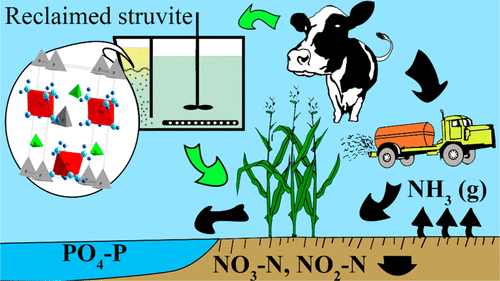当前位置:
X-MOL 学术
›
ACS Sustain. Chem. Eng.
›
论文详情
Our official English website, www.x-mol.net, welcomes your
feedback! (Note: you will need to create a separate account there.)
Aerated Fluidized Bed Treatment for Phosphate Recovery from Dairy and Swine Wastewater
ACS Sustainable Chemistry & Engineering ( IF 7.1 ) Pub Date : 2017-11-29 00:00:00 , DOI: 10.1021/acssuschemeng.7b02990 Alon Rabinovich 1 , Ashaki A. Rouff 1 , Beni Lew 2 , Marlon V. Ramlogan 1
ACS Sustainable Chemistry & Engineering ( IF 7.1 ) Pub Date : 2017-11-29 00:00:00 , DOI: 10.1021/acssuschemeng.7b02990 Alon Rabinovich 1 , Ashaki A. Rouff 1 , Beni Lew 2 , Marlon V. Ramlogan 1
Affiliation

|
An aerated fluidized bed reactor (aerated-FBR) was used for recovery of orthophosphate (PO4–P) from dairy wastewater (D-WW) and swine wastewater (S-WW) by struvite (MgNH4PO4·6H2O) precipitation. Model wastewater solutions (S-model, D-model) free of organic material were also treated. The maximum PO4–P recovery for treated livestock wastes was 94% for S-WW and 63% for D-WW. The PO4–P recovery did not improve for S-model compared to S-WW, but increased to 81% for D-model relative to D-WW, suggesting that the high organic content of D-WW may hinder the recovery process. X-ray diffraction (XRD) analysis of recovered solids revealed that treated S-WW produced mostly struvite (95–98%) while D-WW yielded a mixture of struvite (28–33%), calcite (CaCO3; 17–55%), and monohydrocalcite (CaCO3·H2O; 13–42%). The Fourier transform infrared (FTIR) spectra of the solids confirm the presence of vibrational bands associated with these minerals. Simultaneous thermal analysis (STA) indicated that all solids, except for D-WW, show thermogravimetric (TG) trends consistent with the struvite and calcium carbonate content. The D-WW solids had additional TG steps, possibly due to high organic and colloidal content, and slightly improved ammonium stability. The aerated-FBR treatment is an effective method to reduce PO4–P from livestock wastewater through precipitation of pure struvite and struvite/calcium carbonate mixtures.
中文翻译:

曝气流化床处理法从乳牛和猪废水中回收磷酸盐
曝气流化床反应器(充气FBR)用于通过鸟粪石(MgNH 4 PO 4 ·6H 2 O)从乳品废水(D-WW)和猪废水(S-WW)中回收正磷酸盐(PO 4 -P )沉淀。还处理了不含有机物质的模型废水溶液(S模型,D模型)。处理后的牲畜废物的最大PO 4 -P回收率对于S-WW为94%,对于D-WW为63%。PO 4与S-WW相比,S模型的–P回收率没有改善,但相对于D-WW,D模型的P回收率提高了81%,这表明D-WW的高有机物含量可能会阻碍回收过程。对回收的固体进行的X射线衍射(XRD)分析表明,处理过的S-WW主要产生鸟粪石(95-98%),而D-WW则产生了鸟粪石(28-33%),方解石(CaCO 3; 17-55 %)和单氢方解石(CaCO 3 ·H 2O; 13–42%)。固体的傅立叶变换红外(FTIR)光谱证实了与这些矿物相关的振动带的存在。同时热分析(STA)表明,除D-WW外,所有固体均显示出与鸟粪石和碳酸钙含量一致的热重(TG)趋势。D-WW固体具有额外的TG步骤,这可能是由于有机和胶体含量高,以及铵稳定性略有提高。充气式FBR处理是通过沉淀纯鸟粪石和鸟粪石/碳酸钙混合物来减少牲畜废水中PO 4 -P的有效方法。
更新日期:2017-11-29
中文翻译:

曝气流化床处理法从乳牛和猪废水中回收磷酸盐
曝气流化床反应器(充气FBR)用于通过鸟粪石(MgNH 4 PO 4 ·6H 2 O)从乳品废水(D-WW)和猪废水(S-WW)中回收正磷酸盐(PO 4 -P )沉淀。还处理了不含有机物质的模型废水溶液(S模型,D模型)。处理后的牲畜废物的最大PO 4 -P回收率对于S-WW为94%,对于D-WW为63%。PO 4与S-WW相比,S模型的–P回收率没有改善,但相对于D-WW,D模型的P回收率提高了81%,这表明D-WW的高有机物含量可能会阻碍回收过程。对回收的固体进行的X射线衍射(XRD)分析表明,处理过的S-WW主要产生鸟粪石(95-98%),而D-WW则产生了鸟粪石(28-33%),方解石(CaCO 3; 17-55 %)和单氢方解石(CaCO 3 ·H 2O; 13–42%)。固体的傅立叶变换红外(FTIR)光谱证实了与这些矿物相关的振动带的存在。同时热分析(STA)表明,除D-WW外,所有固体均显示出与鸟粪石和碳酸钙含量一致的热重(TG)趋势。D-WW固体具有额外的TG步骤,这可能是由于有机和胶体含量高,以及铵稳定性略有提高。充气式FBR处理是通过沉淀纯鸟粪石和鸟粪石/碳酸钙混合物来减少牲畜废水中PO 4 -P的有效方法。











































 京公网安备 11010802027423号
京公网安备 11010802027423号